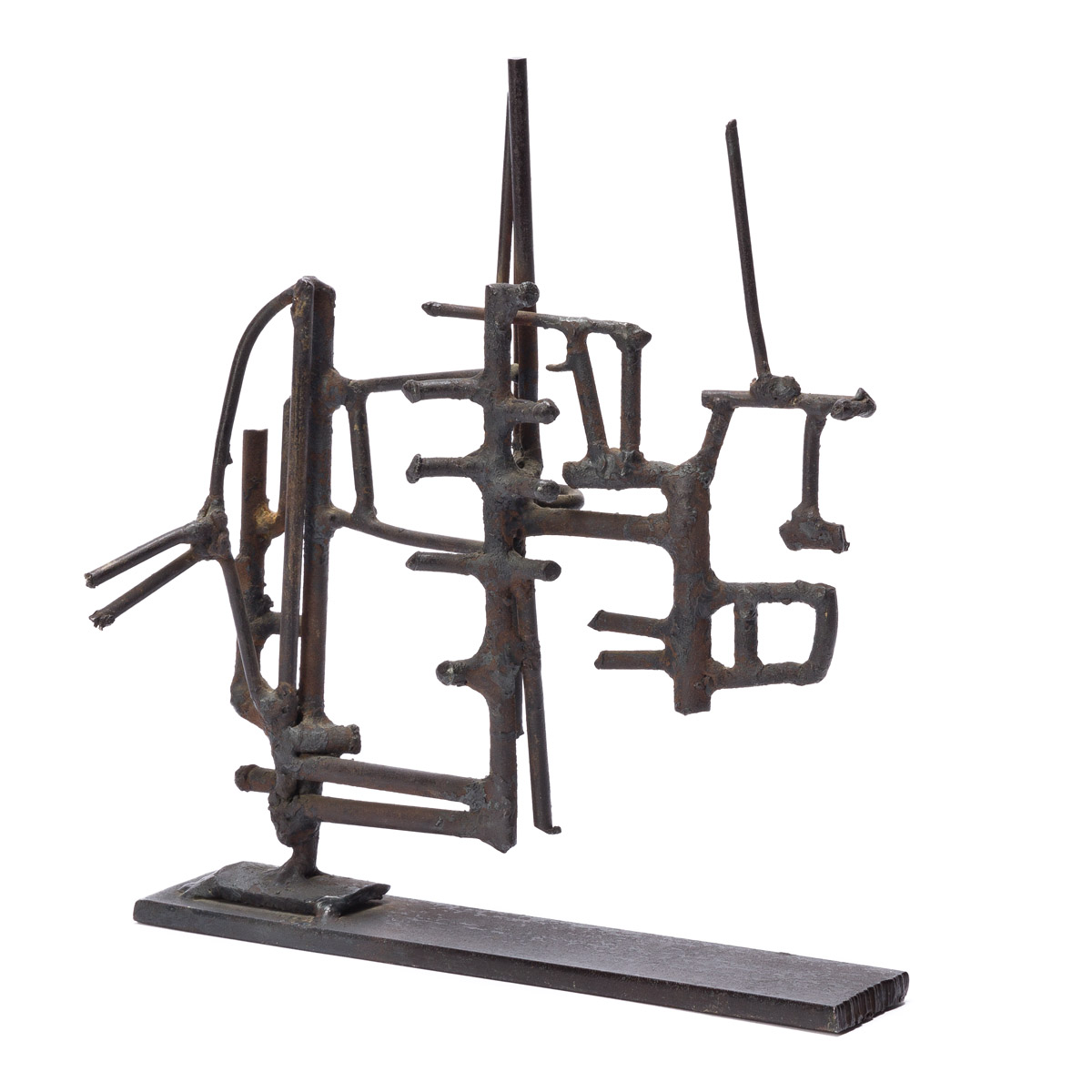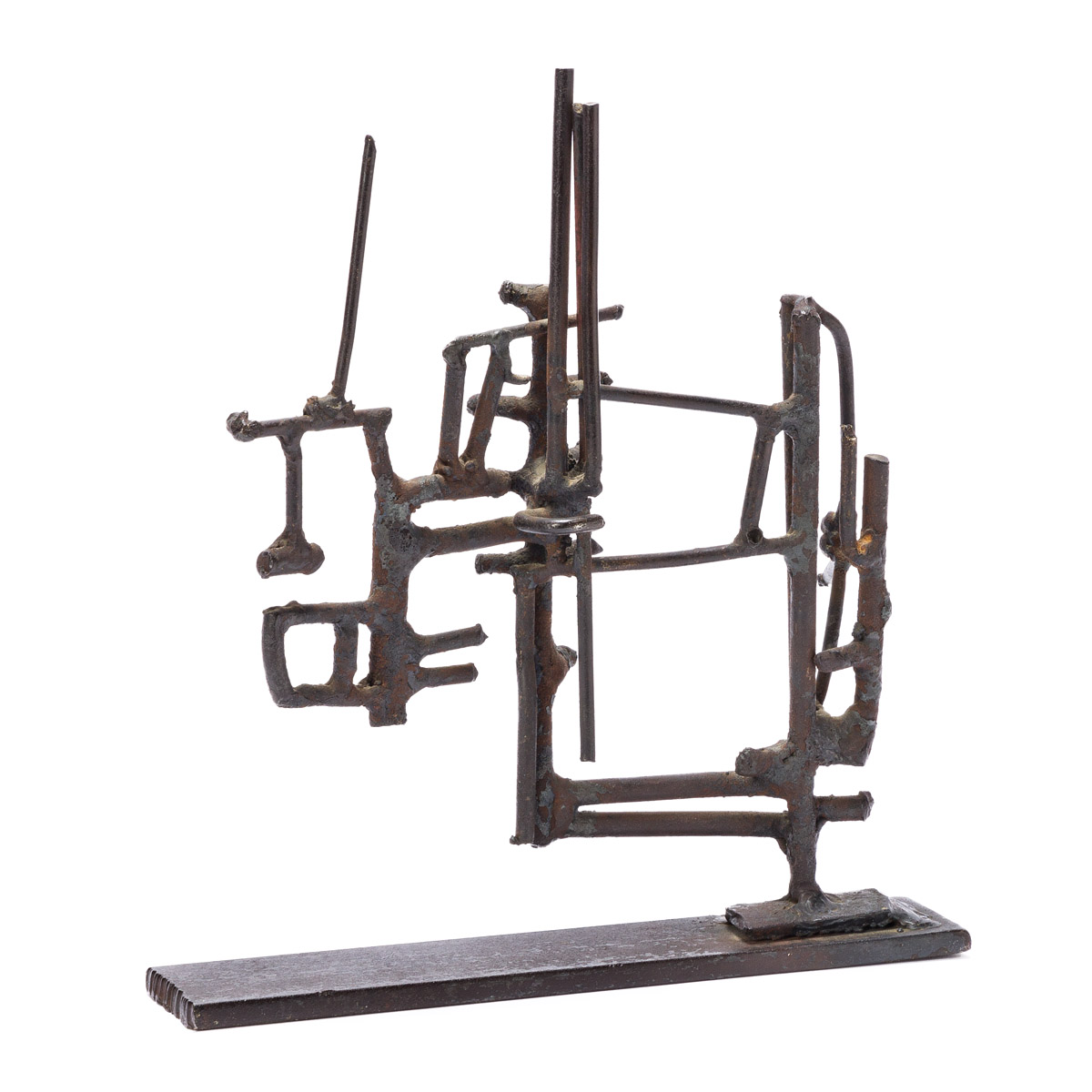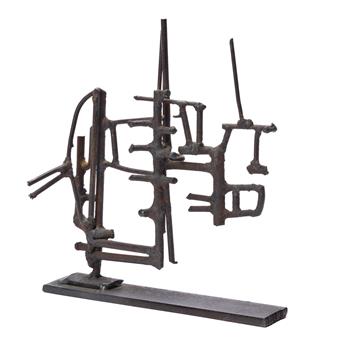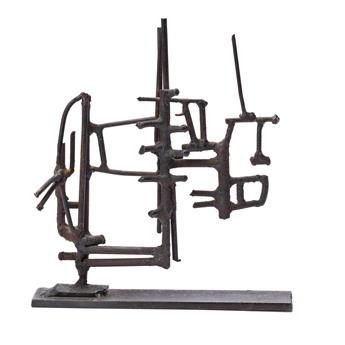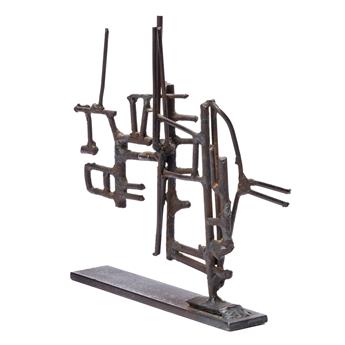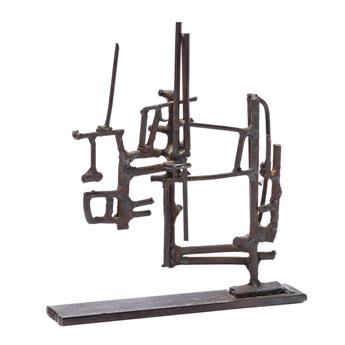Sale 2622 - Lot 46
Unsold
Estimate: $ 70,000 - $ 100,000
JOHN CHAMBERLAIN
Untitled.
Steel, 1954. 229x200x760 mm; 9x8x3 inches.
Provenance: Gifted by the artist to Joel Oppenheimer and Rena Rosequist, 1956; thence by descent to current owner, private collection, New York.
Published Julie Sylvester, John Chamberlain: A Catalogue Raisonné of the Sculpture 1954-1985, 1986, page 44, number 3 (illustrated).
According to Sylvester, this sculpture was made by Chamberlain (1927-2011) very early in his career in Chicago; it is his first sculpture made from steel rods.
Rena Rosequist (born Rena Furlong, 1931-2019) was born in Hickory, North Carolina and attended the Women's College of the University of North Carolina, where she was exposed to the work of young modern artists, like Jackson Pollock (1912-1956). After graduation, she attended the progressive Black Mountain College and continued her studies in art and art history. During her time at Black Mountain College, Rosequist met her first husband, poet Joel Oppenheimer (1930-1988), who attended until 1953. By 1955, Chamberlain (1927-2011) had followed friend and fellow artist, Gerry van de Wiele (born 1932) from the Art Institute of Chicago to Black Mountain College, where Chamberlain would meet Rosequist (Chamberlain attended Black Mountain College from 1955 to 1956). Eventually Oppenheimer, Rosequist, and Chamberlain migrated to New York, and though Oppenheimer and Rosequist divorced by 1960, Rosequist and the itinerant Chamberlain kept in touch. Rosequist moved to Taos, New Mexico and operated Mission Gallery with her second husband, Ivan Rosequist from 1962 to 2017.
According to Gagosian Gallery, New York, which has represented the estate of John Chamberlain, "In the mid-1940s Chamberlain spent nearly three years aboard an aircraft carrier while serving in the US Navy. Traveling through the Pacific, Mediterranean, and Atlantic greatly influenced his sense of scale and viewpoint. Following his return to the United States, he studied at the Art Institute of Chicago (1951–52) and then at Black Mountain College in North Carolina (1955–56), where he fostered a keen appreciation for poetry and began to consider language as an integral part of his aesthetic approach.
Chamberlain moved to New York in 1956 and the following year made Shortstop, his first sculpture incorporating automobile parts. He continued to use this material, revealing the seemingly infinite formal potential of the shining chrome, flaking paint, hard edges, and voluminous folds. In 1961 his innovations led to his inclusion in the 'Art of Assemblage' at New York's Museum of Modern Art, where his sculptures were shown alongside Futurist, Surrealist, and Cubist works.
At the end of the 1960s Chamberlain began to incorporate galvanized steel, urethane foam, and mineral-coated Plexiglas into his work. Despite the physical differences of these materials, Chamberlain was consistent in his approach, constantly searching for the right 'fit' and rearranging compositions until they 'locked into place.
Chamberlain returned to the nearly exclusive use of automobile parts in the mid-1970s, expanding his technique by cutting and painting the metal. Seeking a larger studio space with higher ceilings where he could expand the scale of his work, he moved from New York to Sarasota, Florida, in 1980. There he made the Gondolas (1981–82), long, low works often displayed in pairs or groups on the floor, like abstracted boats floating in a row. For the Giraffe series (1982–83), he sandblasted painted car metal, removing the color in patterned, linear strips to reveal the raw surface beneath.
Chamberlain is considered among the most important and influential 20th century sculptors, his dynamic work blends Abstract Expressionism, Pop Art and Minimalism, and can be found in public collections worldwide, including the Centre Pompidou, Paris; the Hirshhorn Museum and Sculpture Garden, Washington, D.C.; the Moderna Museet, Stockholm; the Solomon R. Guggenheim Museum, New York; Tate Modern, London; the Whitney Museum of American Art, New York; and the Museum of Modern Art, New York.
Untitled.
Steel, 1954. 229x200x760 mm; 9x8x3 inches.
Provenance: Gifted by the artist to Joel Oppenheimer and Rena Rosequist, 1956; thence by descent to current owner, private collection, New York.
Published Julie Sylvester, John Chamberlain: A Catalogue Raisonné of the Sculpture 1954-1985, 1986, page 44, number 3 (illustrated).
According to Sylvester, this sculpture was made by Chamberlain (1927-2011) very early in his career in Chicago; it is his first sculpture made from steel rods.
Rena Rosequist (born Rena Furlong, 1931-2019) was born in Hickory, North Carolina and attended the Women's College of the University of North Carolina, where she was exposed to the work of young modern artists, like Jackson Pollock (1912-1956). After graduation, she attended the progressive Black Mountain College and continued her studies in art and art history. During her time at Black Mountain College, Rosequist met her first husband, poet Joel Oppenheimer (1930-1988), who attended until 1953. By 1955, Chamberlain (1927-2011) had followed friend and fellow artist, Gerry van de Wiele (born 1932) from the Art Institute of Chicago to Black Mountain College, where Chamberlain would meet Rosequist (Chamberlain attended Black Mountain College from 1955 to 1956). Eventually Oppenheimer, Rosequist, and Chamberlain migrated to New York, and though Oppenheimer and Rosequist divorced by 1960, Rosequist and the itinerant Chamberlain kept in touch. Rosequist moved to Taos, New Mexico and operated Mission Gallery with her second husband, Ivan Rosequist from 1962 to 2017.
According to Gagosian Gallery, New York, which has represented the estate of John Chamberlain, "In the mid-1940s Chamberlain spent nearly three years aboard an aircraft carrier while serving in the US Navy. Traveling through the Pacific, Mediterranean, and Atlantic greatly influenced his sense of scale and viewpoint. Following his return to the United States, he studied at the Art Institute of Chicago (1951–52) and then at Black Mountain College in North Carolina (1955–56), where he fostered a keen appreciation for poetry and began to consider language as an integral part of his aesthetic approach.
Chamberlain moved to New York in 1956 and the following year made Shortstop, his first sculpture incorporating automobile parts. He continued to use this material, revealing the seemingly infinite formal potential of the shining chrome, flaking paint, hard edges, and voluminous folds. In 1961 his innovations led to his inclusion in the 'Art of Assemblage' at New York's Museum of Modern Art, where his sculptures were shown alongside Futurist, Surrealist, and Cubist works.
At the end of the 1960s Chamberlain began to incorporate galvanized steel, urethane foam, and mineral-coated Plexiglas into his work. Despite the physical differences of these materials, Chamberlain was consistent in his approach, constantly searching for the right 'fit' and rearranging compositions until they 'locked into place.
Chamberlain returned to the nearly exclusive use of automobile parts in the mid-1970s, expanding his technique by cutting and painting the metal. Seeking a larger studio space with higher ceilings where he could expand the scale of his work, he moved from New York to Sarasota, Florida, in 1980. There he made the Gondolas (1981–82), long, low works often displayed in pairs or groups on the floor, like abstracted boats floating in a row. For the Giraffe series (1982–83), he sandblasted painted car metal, removing the color in patterned, linear strips to reveal the raw surface beneath.
Chamberlain is considered among the most important and influential 20th century sculptors, his dynamic work blends Abstract Expressionism, Pop Art and Minimalism, and can be found in public collections worldwide, including the Centre Pompidou, Paris; the Hirshhorn Museum and Sculpture Garden, Washington, D.C.; the Moderna Museet, Stockholm; the Solomon R. Guggenheim Museum, New York; Tate Modern, London; the Whitney Museum of American Art, New York; and the Museum of Modern Art, New York.
Exhibition Hours
Exhibition Hours
Aliquam vulputate ornare congue. Vestibulum maximus, libero in placerat faucibus, risus nisl molestie massa, ut maximus metus lectus vel lorem.



